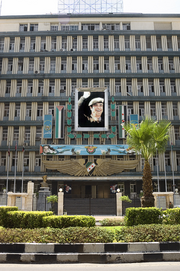Air Force Intelligence Directorate
This article is incomplete because it is pending further input from participants, or it is a work-in-progress by one author. Please comment on this article's talk page to share your input, comments and questions. Note: To contribute to this article, you may need to seek help from the author(s) of this page. |
| إدارة المخابرات الجوية Idaraat al-Mukhabarat al-Jawiyah | |
 Seal of the Mukhabarat. | |
 Headquarters building of the Mukhabarat. | |
| Agency overview | |
|---|---|
| Formed | December 10, 1927 |
| Headquarters | T1 Airbase, Tel al-Riyah |
| Motto | أَحَطتُ بِمَا لَمْ تُحِطْ بِهِ I have encompassed in knowledge that which you have not. (Al-Naml 27:22) |
| Employees | Est. 25,000 (2013) |
| Annual budget | Est. $4.7 billion (2013) |
Mission
Organization
Facilities
Budget
As with virtually everything tied to the Mukhabarat, its budget is a state secret. Details from leaked partner documents suggest that the Air Force Intelligence Directorate's budget in 2013 was around $4.76 billion, broken down into the following:
- Intelligence collection: $1.52 billion
- Intelligence processing: $0.62 billion
- Data analysis: $0.51 billion
- Research & technology:: $0.27 billion
- Clandestine operations: $0.50 billion
- Support and logistics: $1.44 billion
It is unclear how accurate these figures are, and if this includes foreign currency used for clandestine operations. Furthermore, as the Mukhabarat is suspected to be engaged in counterfeiting and cyber-attacks against enemy financial institutions, its official budget is not necessarily equal to the true amount of money available for its use.
Training, personnel, and recruitment
Recruitment
Mukhabarat officers are recruited from the branches of the Riysian Armed Forces, primarily from the Riysian Arab Air Force and reconnaissance units of all branches, or are scouted out while they're still studying in a university. The former method used to be the most common way up until the 1980s, by picking out officers to service in field military intelligence units, and then from there inducting the best officers into the rest of the organization. However, with the digital revolution and an ever increasing need for highly specialized scientists and engineers, the latter is now the predominant method of recruiting officers into the Directorate.
In either case, officers are selected based on their technical and analytical skills, as well as their political reliability, and are approached in a targeted manner - independent applications and volunteers are rarely if ever accepted.
Personnel
It is estimated that the Directorate has approximately 25,000 full time employees on staff. Approximately 87% of employees are men and 13% are women, reflecting both its militaristic culture, and Riysa's highly conservative and traditional culture. Based on known information, the majority of women in the Mukhabarat serve in the Administrative Directorate (J), with some working as analysts, and a few are operational officers abroad; however, Technical Intelligence (B) and Operational Science & Technology (H) have virtually none.
As the Mukhbarat is a military organization, employees are all commissioned officers and hold rank. The commander of the Air Force Intelligence Directorate nominally holds the rank of Colonel-General, and the most common rank is believed to be Colonel. However, due to the nature of the Mukhabarat, rank does not necessarily equal authority - captains may be filling roles typically held by a major or lieutenant colonel, or vice versa.
Training
College of the Air Force Intelligence Directorate
All new hires